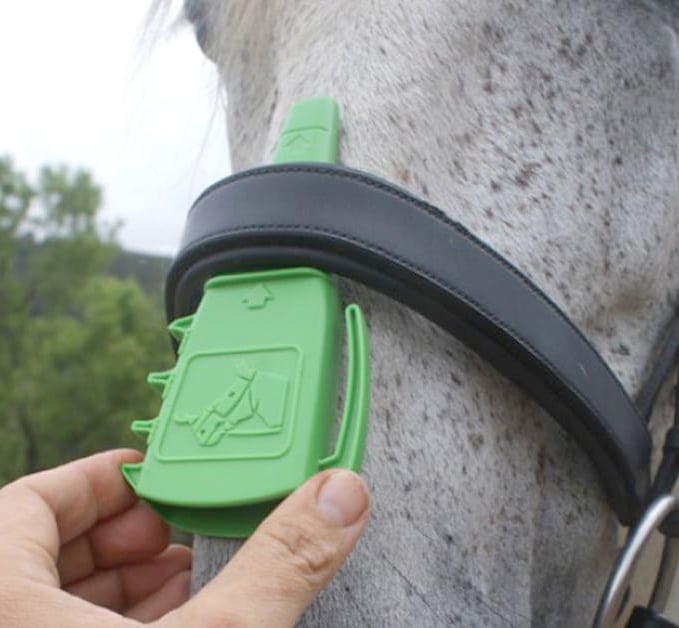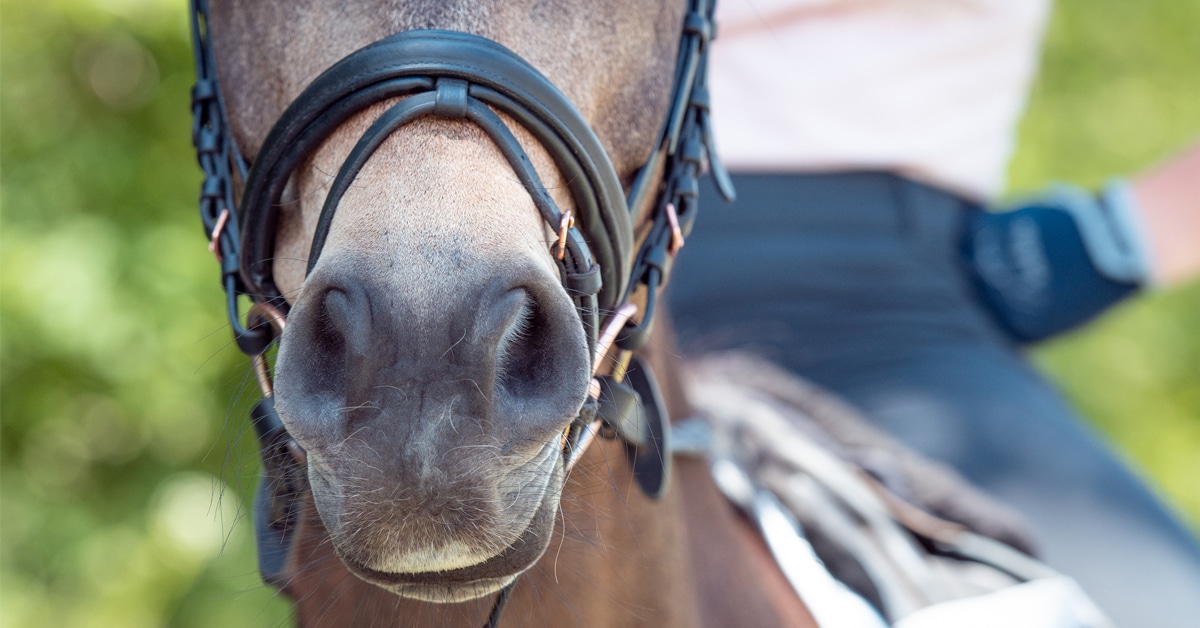If you competed during the summer of 2021 and were selected for a tack check, you may have noticed something different. As part of a pilot project launched by Equestrian Canada (EC) last year, stewards at certain shows were armed with a new tool, a plastic gauge designed to measure noseband tightness.
In announcing the pilot project, here’s what Kristy Laroche, EC Director of Active Equine Industry and Development said: “The Equine Health and Welfare Committee will be working towards the implementation of a rule that reflects the scientific recommendations (Fenner et al. 2016; McGreevy et al. 2012; Randle and McGreevy 2013; Pospisil et al. 2014; Casey et al. 2013; Murray et al. 2015; Doherty 2016) that an equine’s noseband should not be tight enough to prevent the placement of two adult fingers between the noseband and the frontal nasal plane. As the size of two fingers can vary between the person who applied the noseband to the equine and the official assessing compliance with the rule, the committee plans to recommend the standardized use of the International Society for Equitation Science (ISES) Taper Gauge to help ensure consistent measurements and an equine welfare-friendly field of play.”

The taper guage. While most agree that overly-tight nosebands can be a welfare issue, is it possible the measuring device could be as well? (ISES photo)
EC hosted a webinar in November with various pilot participants to review the results. Each speaker in turn praised the idea of a consistent standard for measuring noseband tightness and spoke highly of the measuring device tested. Based on the webinar alone, it would be easy to conclude the project was a resounding success.
But not so fast.
A number of stakeholders have advised HorseSport that dissenting views have not been welcomed by EC, and that commenting and chat features were turned off to prevent concerns being raised during the webinar. Among those asking for consideration of additional options is Dr. Alan Young, an FEI-accredited vet who served as the Team Canada veterinarian for 23 years at multiple Olympics, World Championships and Pan Am Games.
“The idea is right,” states Young. “Everyone should be appalled by overly-tight nosebands, and everyone agrees on that. But it’s really important that the adoption of this particular measuring device doesn’t get rammed through without more research, rather than just basing decisions on marketing presentations by its manufacturer.”
Chief among Young’s concerns are the method of measuring with this device, the construction of the device itself, the safety risks its use presents to stewards, riders, and horses, and a lack of scientific data supporting the proposal.
“There is no science behind EC’s proposal. There is no scientific standard for determining what ‘too tight’ means, or even where tightness should be measured,” he explains. “The ‘two-finger rule’ we’ve all heard comes from a quote by a well-known rider; there is no scientific study stating two fingers is the standard, how big those fingers should be, or where under the bridle they should be placed. I have serious concerns about measuring on the nasal bone, from a scientific standpoint, from a safety standpoint, and from an ethical standpoint.”
Young points to flaws in the research presented by ISES and accepted by EC.
“Two radiographic studies being quoted to show that nosebands cause facial deformity explicitly state that they have not established lesions were caused by nosebands. In another study of more than 3,000 competition horses, those that wore no nosebands showed 2.4 times the number of mouth lesions as those that wore properly adjusted nosebands. That study was not quoted in the presentations about this device. There is much more information available on the subject, but EC has repeatedly shut down any opportunity for input.”
“There is no consideration of the biosecurity risk, the safety risk to stewards using this device, and the potential of causing further discomfort to a horse by shoving a hard plastic tool under an already questionably tight noseband.”
“There is no consideration in this proposal for different types of nosebands such as drops, flashes, or the newer anatomical styles. There is no consideration of the biosecurity risk, the safety risk to stewards using this device, and the potential of causing further discomfort to a horse by shoving a hard plastic tool under an already questionably tight noseband. Doing this on the nasal bone only creates more pressure and potentially pain. How is that ethical?”
What does Young suggest as an alternative? If measuring over bone is determined to be the best approach, he recommends measuring on the jawbone at the side of the horse’s head to minimize discomfort to the horse, reduce the biosecurity risk of droplets being sprayed from the horse’s nostrils, and protect the safety of the stewards. Further, he would like to see a committee set up to thoroughly evaluate all the research and options available.
Mary Bell, who is both an FEI accredited vet and an FEI steward, shares many of Young’s concerns.
“In general, I think overly tight nosebands are much less of an issue now than years ago when I first became a steward,” she says. “I’m not saying we shouldn’t have a standard measurement, but there are deficits in the research on this particular device. Personally, I’d prefer to see one that could be comfortably used on the side of the jaw, below the bit, and it would be nice to have one which fit into the thumb of a disposable glove. It’s easier for stewards to slip their thumb quickly under the noseband, and the use of a fresh glove every time reduces the biosecurity risk and the time it takes to properly disinfect the measuring tool between each horse.”
Bell also points to potential issues of fairness in how the device might be used at competitions.
“If we are going to create a rule that noseband tightness gets measured, it must be applied fairly and equally to every horse. That’s going to create a staffing issue. Often there is only one steward at a national show, monitoring multiple warm up rings. Stewards are already stretched thin at competitions. Implementing this device would create a serious problem in terms of the number of stewards required, and the time it would take to safely use it. There are horses for which this device and/or this location of measurement will never be a safe option for the horse, the steward, the groom or the spectators.”
“Are tight nosebands an issue?” she continues. “Yes, in certain disciplines. But it’s an issue that is already addressed under the existing rules. The FEI has chosen not to adopt this measuring tool, nor has it confirmed the measuring location should be on the bridge of the nose. I’m uncomfortable accepting this particular device and believe alternatives should be investigated.”
Veterinarians and stewards aren’t the only ones questioning whether EC’s proposal should be accepted. Two-time Olympic dressage rider Jacqueline Brooks shared some of her concerns as a rider.
“Over-tightening the noseband is dangerous, but leaving the noseband too loose is also cruel within the demands of our sport,” she says. “What’s the perfect amount? That depends on the horse and the discipline. The noseband serves an important purpose, providing support to the horse and helping the rider help the horse regain balance when it is momentarily lost. In the dressage ring and in the jumper ring, especially at big competitions when the horses are up and a little excited, we rely on split-second timing from our aid to the horse’s reaction. Any delay in the horse receiving that aid is detrimental to the idea of the sport. Sport is a constant loss and regaining of balance. Those who do it in the quickest and most seamless way become the winners.
“What’s the line between effective pressure and cruel pressure?” she asks. “Currently there is no standard. I don’t disagree with having one, but they haven’t established scientifically what that standard should be. If I own a pair of shoes that are too small and too tight, buying a pair that are too big and loose does not solve the problem. It just changes to a different problem.”
Brooks has her own ideas how noseband tightness could be more effectively and safely monitored at competitions.
“To me, this is something that should be done in the pre-ride stable check, not at the tack check when the horse is up and excited. This raises obvious concerns about the safety of the stewards in that situation,” she explains. “My issue is that this particular tool is trying to measure pressure by adding more pressure. That doesn’t make sense. If tightness is the problem, then there should be a standard fit. If the nose is a certain circumference, the noseband should be that circumference plus whatever the standard is, say + 0.5 cm for argument’s sake. The stewards could mark the correct hole on the noseband during the in-stall inspections, and then at the tack check just quickly confirm it’s tightened to that hole. If we’re trying to measure pressure, then it would make more sense to use a pressure gauge. However, pressure is really up to the horse. They can apply more pressure to a loose noseband simply by opening their mouth. There is a compromise, but this tool is not appropriate.”
Brooks concludes, “We love our horses. We spend 24 hours a day trying to keep them comfortable and performing their best. The last thing we want to do is hurt them. It doesn’t benefit them, and it doesn’t benefit us.”
Read EC’s response to this article HERE.

